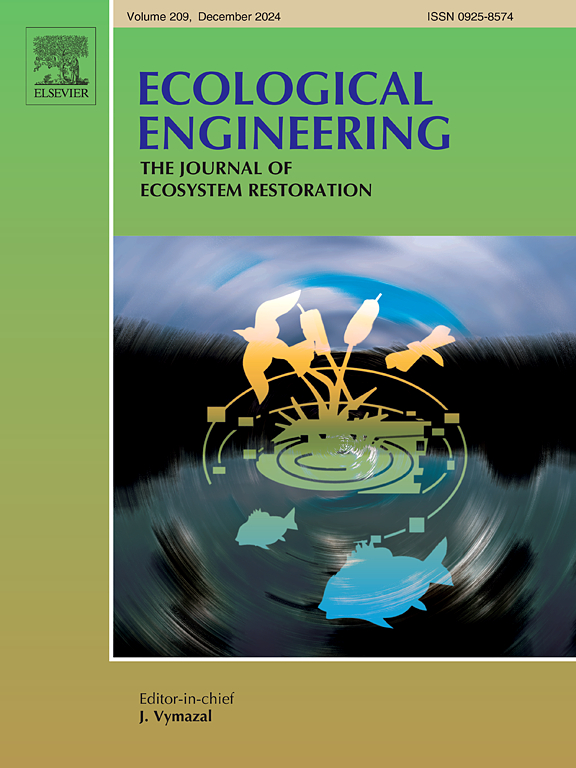Rehabilitating degraded calcareous soil into a metal repository: A focus on particulate organic matter storage
IF 4.1
2区 环境科学与生态学
Q1 ECOLOGY
引用次数: 0
Abstract
Soil particulate organic matter (POM) is crucial for regulating trace metal dynamics by acting as either a sink or source. This study examined cadmium (Cd) storage pathways in POM within calcareous soil that has been degraded by over 50 years of wastewater irrigation. We conducted a microcosm experiment combined with soil incubation and crop cultivation to examine the effects of manure application (2.5 %, 5 %, and 10 %) coupled with recalcification (25 %, 50 %, and 100 % of soil CaCO3 deficit relative to its background level). The results showed that the POM mass percentage and Cd mass load in POM increased as POM size decreased, with 56.93 % of Cd (on average) concentrated in the smallest fraction (0.053–0.25 mm). Manure application increased the absolute mass of all POM sizes (−3.53 % to 45.14 %), although their mass percentages remained stable. Critically, 5 % and 10 % manure significantly elevated the Cd enrichment factor in POMs from <1 (control: 0.39–0.92) to 4.81–12.23 and 2.86–5.24, respectively. However, higher recalcification (50 % and 100 %) diminished manure-induced enrichment. The combination of 5 % manure with low recalcification (25 %) resulted in the lowest Cd content in wheat grains. Soil carbon component and redundancy analyses indicated that Cd enrichment in POM was favored by an organic carbon content >20 g kg−1 and an inorganic/organic carbon ratio < 1. These findings demonstrate that applying 5 % manure coupled with 25 % recalcification is optimal for utilizing POM as a metal repository in degraded calcareous soils.

将退化的钙质土壤恢复为金属储存库:对颗粒有机质储存的关注
土壤颗粒物有机质(POM)是调节痕量金属动态的重要来源或汇。本研究考察了经过50多年的废水灌溉而退化的钙质土壤中POM中镉(Cd)的储存途径。我们进行了一项结合土壤培养和作物栽培的微观实验,以研究施用有机肥(2.5%、5%和10%)和再钙化(土壤CaCO3相对于其背景水平的25%、50%和100%)的效果。结果表明:随着POM粒径的减小,POM中POM的质量百分比和Cd的质量负荷均增大,平均56.93%的Cd集中在最小的部分(0.053 ~ 0.25 mm);施用有机肥增加了所有POM的绝对质量(- 3.53% ~ 45.14%),但它们的质量百分比保持稳定。5%和10%有机肥显著提高了pom中Cd富集因子,分别从1(对照:0.39 ~ 0.92)提高到4.81 ~ 12.23和2.86 ~ 5.24。然而,较高的再钙化(50%和100%)减少了粪便诱导的富集。5%粪肥配25%低再钙化处理的小麦籽粒Cd含量最低。土壤碳组分和冗余分析表明,有机碳含量>;20 g kg - 1和无机/有机碳比<;1. 这些结果表明,施用5%的肥料和25%的再钙化是在退化的钙质土壤中利用POM作为金属库的最佳选择。
本文章由计算机程序翻译,如有差异,请以英文原文为准。
求助全文
约1分钟内获得全文
求助全文
来源期刊

Ecological Engineering
环境科学-工程:环境
CiteScore
8.00
自引率
5.30%
发文量
293
审稿时长
57 days
期刊介绍:
Ecological engineering has been defined as the design of ecosystems for the mutual benefit of humans and nature. The journal is meant for ecologists who, because of their research interests or occupation, are involved in designing, monitoring, or restoring ecosystems, and can serve as a bridge between ecologists and engineers.
Specific topics covered in the journal include: habitat reconstruction; ecotechnology; synthetic ecology; bioengineering; restoration ecology; ecology conservation; ecosystem rehabilitation; stream and river restoration; reclamation ecology; non-renewable resource conservation. Descriptions of specific applications of ecological engineering are acceptable only when situated within context of adding novelty to current research and emphasizing ecosystem restoration. We do not accept purely descriptive reports on ecosystem structures (such as vegetation surveys), purely physical assessment of materials that can be used for ecological restoration, small-model studies carried out in the laboratory or greenhouse with artificial (waste)water or crop studies, or case studies on conventional wastewater treatment and eutrophication that do not offer an ecosystem restoration approach within the paper.
 求助内容:
求助内容: 应助结果提醒方式:
应助结果提醒方式:


